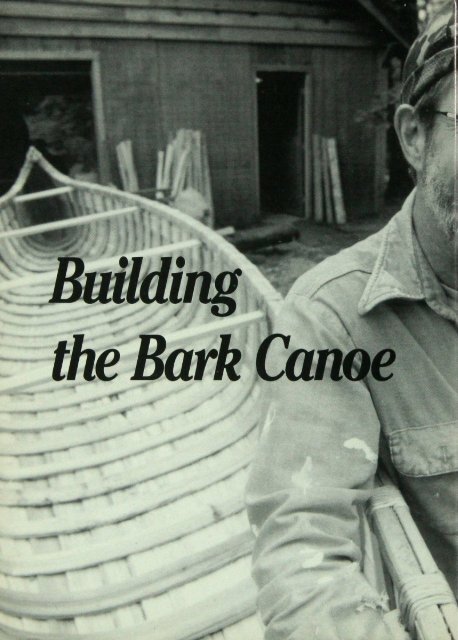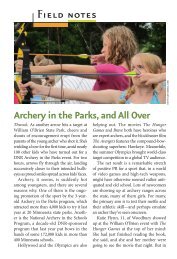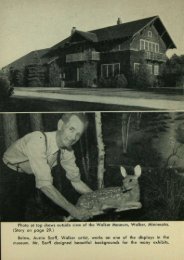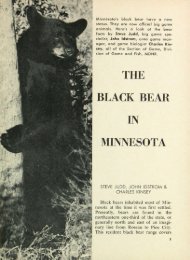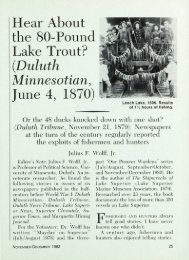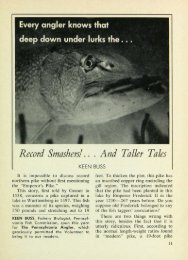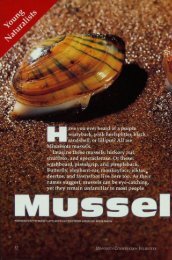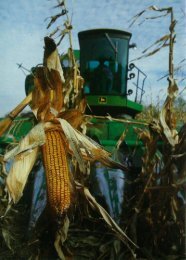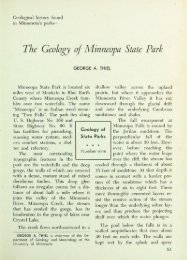282 Building the Bark Canoe - webapps8
282 Building the Bark Canoe - webapps8
282 Building the Bark Canoe - webapps8
- No tags were found...
Create successful ePaper yourself
Turn your PDF publications into a flip-book with our unique Google optimized e-Paper software.
Jack Minehart makes canoes like<strong>the</strong> ones <strong>the</strong> Ojibwe and voyageurspaddled. By Greg Breining.Photographs by Layne KennedyIF YOU ORDER a birch bark canoefrom Jack Minehart, don't leton that you'll cherish it, pamperit, and keep it inside onlyto be seen by guests. Instead, tellhim you'll paddle it, portage it,overload it, and bash this remarkablybeautiful and durablevessel against a rockor two. "If I've got to reserve<strong>the</strong> last building slotin a season for some guy inOhio who's really going toI use it—float <strong>the</strong> Wabash andshoot squirrels out of it—orsome guy who's going to hangit from <strong>the</strong> ceiling of his lodge,I'll take <strong>the</strong> guy in Ohio anytime,"he says.Minehart, a Cedar Falls, Iowa, historyteacher, is one of a handful ofbirch bark canoe builders using <strong>the</strong>same methods and materials employedby nor<strong>the</strong>rn American IndianIn his workshop in Max, Minn., JackMinehart builds bark canoes likethose paddled by woodland Indiansand voyageurs 200 years ago.47
Birch <strong>Bark</strong> <strong>Canoe</strong>stribes for centuries and copied byScottish and British traders andFrench-Canadian voyageurs to pursue<strong>the</strong> fur trade from Montreal toLake Athabasca in far northwesternCanada. He learned <strong>the</strong> trade fromBill Hafeman, a master builder nowin his 90s. Except for <strong>the</strong> efforts of afew diligent craftsmen, <strong>the</strong> secret ofmaking <strong>the</strong>se fast, light canoes mighthave died with old Indian buildersas bark canoes were replaced bywood and canvas in <strong>the</strong> early 1900sand later by aluminum and fiberglass.Minehart's fascination with canoesbegan when he was a youngsterat a summer camp in Vermont,where he paddled on placid nor<strong>the</strong>rnlakes and rushing white water.Hanging from <strong>the</strong> rafters of <strong>the</strong> messhall was a bark canoe. The old boatapparently worked its magic on <strong>the</strong>young campers who said grace andchowed down beneath its tawnybark: One of Minehart's tent mateswas John McPhee, who later wroteabout New England canoe builderHenri Vaillancourt in The Survival of<strong>the</strong> <strong>Bark</strong> <strong>Canoe</strong> (New York: WarnerBooks, 1975), perhaps <strong>the</strong> most fa-An old-timer to <strong>the</strong> Big Fork River, Bill Hafeman taught Minehart to build canoes.48 THE MINNESOTA VOLUNTEER
Birch <strong>Bark</strong> <strong>Canoe</strong>sMiriehart sews toge<strong>the</strong>r sheets of bark with <strong>the</strong> split root of <strong>the</strong> black spruce.made <strong>the</strong>m for about 10 years andgave <strong>the</strong>m away all <strong>the</strong> time/' he says."I kept thinking I should be able tomake <strong>the</strong>m better."As Hafeman's technique improvedand his fame spread, orders pouredinto his shop. For <strong>the</strong> U. S. ForestService, he built a 25-foot canot dunord, <strong>the</strong> craft <strong>the</strong> voyageurs used tocarry trade goods and furs across <strong>the</strong>Greg Breinitig is associate editor of <strong>the</strong>Volunteer and a free-lance writer. LayneKennedy is a free-lance photographer.This story first appeared in <strong>the</strong> August1991 issueof Country Journal. Originalphotographs are in color.interior waterways of North America.He supplied a canoe to <strong>the</strong> WhiteHouse in 1967 for <strong>the</strong> dedication of<strong>the</strong> Sylvania Wilderness Area inMichigan's Upper Peninsula. TheMinnesota Historical Society boughta 36-foot canot de maitre, <strong>the</strong> voyageurs'Great Lakes canoe. It tookHafeman an entire summer to build,and when finished it was too big tosqueeze into <strong>the</strong> exhibit area.Minehart was fascinated byHafeman and his boats. He wouldspend long hours hanging around<strong>the</strong> boat works to help. Finally,Hafeman asked, "Why don't youspend <strong>the</strong> summer? You've learned so50 THE MINNESOTA VOLUNTEER
much, you might as well learn <strong>the</strong>whole thing.""Altoge<strong>the</strong>r I probably spent sixmonths in that shop learning what Ihad to learn," Minehart recalls."Then I probably spent ano<strong>the</strong>r sixmonths in my own shop learningmore of what I had to learn."During <strong>the</strong> 11 summers since,Minehart has built with commonhand tools more than 30 canoes athis own shop and cabin on LittleSand Lake. Some have exceeded 20feet; o<strong>the</strong>rs have been as short as 6.But most have been 16- to 17-footersbased on Ojibwe, Cree, Micmac, andMalecite designs. Each weighs onlyabout 60 pounds—less than mostaluminum canoes.Methods of <strong>the</strong> Master. Mineharf smethods, with a few modifications,are Hafeman's. "He's <strong>the</strong> master. Ilearned from him," Minehart says.Once an order comes in, Minehartsearches for materials. "Usually somebody'sgot a timber lease and lets meknow if he's got some good birch orgood cedar on it before he cuts it."Minehart looks for a birch at least20 inches around with a good straighttrunk. Then he uses an 8-foot ladderto climb and shimmy up <strong>the</strong> tree asfar as he can. Using a walking stickas a guide, he cuts a vertical slit nearlyto <strong>the</strong> base of <strong>the</strong> tree. Mineharttakes his bark in spring and earlysummer, when <strong>the</strong> sap is running.Bent in forms, <strong>the</strong> laminated stem piecesare <strong>the</strong>n wrapped with basswood innerbark and sewn into <strong>the</strong> bow and sternto form <strong>the</strong> canoe's profile.JANUARY-FEBRUARY 1992 51
Minehart splits out thin sheets of white cedar he finds in <strong>the</strong> woods near his shop."When <strong>the</strong> sun is shining and <strong>the</strong>tree is really processing through thatcambium layer, it's well lubricated—<strong>the</strong> tree practically peels itself." Evenpeeled, <strong>the</strong> trees survive, as long as<strong>the</strong> cambium—<strong>the</strong> layer of cells between<strong>the</strong> wood and <strong>the</strong> bark—isnot damaged. They can be cut laterfor firewood, pulpwood, or veneer.In <strong>the</strong> days when Hafeman beganbuilding, he could sometimes buildan entire canoe from a single piece ofbark. "His own canoe is that way,"Minehart says. "It makes a strongerboat and cuts down on all <strong>the</strong> timeyou have to spend stitching." Butpulp cutters have taken <strong>the</strong> big trees,and "if <strong>the</strong>re are any more like thatleft up <strong>the</strong>re, I've never run acrossone," Minehart says. Today, he maycut bark from five or six trees tobuild a 16-foot canoe.Minehart also needs a long pieceof <strong>the</strong> inner bark of a basswood treefor binding <strong>the</strong> curved stem piecesin <strong>the</strong> bow and stern. He cuts a smallslit on <strong>the</strong> trunk of a basswood, takeshold of <strong>the</strong> bark and pulls, peeling aribbon right up <strong>the</strong> tree.Next, Minehart finds a couple ofknot-free cedars, from which he cutslogs up to 20 feet long for making54 THE MINNESOTA VOLUNTEER
Minehart lines <strong>the</strong> birch bark with cedar sheathing to stiffen and streng<strong>the</strong>n <strong>the</strong> hull.<strong>the</strong> gunwales, ribs, and sheathing.Finally, he slogs into a peat bog togrub <strong>the</strong> 300 feet of black-spruceroot used to sew pieces of bark toeach o<strong>the</strong>r, fasten <strong>the</strong> bark to <strong>the</strong>gunwales, and lash wood toge<strong>the</strong>r.He digs around <strong>the</strong> base of a largetree, finds a pencil-sized root, andpulls up to 20 feet of it out of <strong>the</strong>ground. Back at <strong>the</strong> shop, he splits<strong>the</strong> root down <strong>the</strong> middle so it willhe flat against <strong>the</strong> bark and wood."I used to feel I could ga<strong>the</strong>r all<strong>the</strong> material for a canoe in a day,"Minehart says. "Now I'd say it takesmore like two and a half to threedays. If s harder to find <strong>the</strong> quality. Ittakes more scouting every year."Not Like Hollywood. Unlikewood and canvas boats, birch barkcanoes are built right-side up. Minehartsews <strong>the</strong> bark into a single largepiece and lays it inside a buildingframe of upright stakes, which hold<strong>the</strong> bark in <strong>the</strong> shape of a hog trough.(Indians simply pounded 2-footstakes into <strong>the</strong> ground to form <strong>the</strong>outline of <strong>the</strong> canoe.) Contrary to <strong>the</strong>image propagated by Hollywood,<strong>the</strong> tan inner bark forms <strong>the</strong> outsideof <strong>the</strong> hull, because <strong>the</strong> papery whiteJANUARY-FEBRUARY 1992 53
Birch <strong>Bark</strong> <strong>Canoe</strong>sside would soon wear away. "Amovie company wanted to get Bill tobuild one with <strong>the</strong> white side out,"Minehart recalls. "They thought thatwas <strong>the</strong> way people would want tosee it. But Bill thought it over andsaid, 'I'm just not going to do it. Iwork too hard at this.' He turneddown a whale of a commission."With <strong>the</strong> bark in place, Minehartbends laminated cedar into stempieces, wraps <strong>the</strong>m with basswoodbark so <strong>the</strong>y hold <strong>the</strong>ir shape, andsews <strong>the</strong>m into <strong>the</strong> bow and stern.Next he splits out cedar gunwales,which he clamps to <strong>the</strong> upright stakesof <strong>the</strong> building frame. He drills a seriesof holes down <strong>the</strong> sides of <strong>the</strong>hull, just beneath <strong>the</strong> gunwales, andlashes <strong>the</strong> bark and gunwales toge<strong>the</strong>r.'Tower tools help when <strong>the</strong>re's somelittle job like drilling <strong>the</strong> holes forside bindings. When you build for amarket, you've got to make somecompromises in <strong>the</strong> old Indian ways."Minehart splits out several dozencedar planks Vi6 inch thick, severalinches wide, and several feet long toline <strong>the</strong> hull. Two dozen cedar boards5/i6 inch thick form <strong>the</strong> canoe's ribs.He steams or boils <strong>the</strong> pieces tosoften <strong>the</strong>m, and bends each to shapeusing his eye alone as a guide. "Youdecide <strong>the</strong>n whe<strong>the</strong>r you're going tohave a flat-bottomed canoe, a shallowarch, or a round bottom."He drives <strong>the</strong> ribs into place, beginningwith those at <strong>the</strong> ends. Eachnew rib tightens <strong>the</strong> skin of bark, and<strong>the</strong> last rib locks into place amidships.One Concession. Then Minehartlashes <strong>the</strong> thwarts (crosspieces) inplace, pinching <strong>the</strong> hull inward against<strong>the</strong> tension of <strong>the</strong> ribs to get <strong>the</strong> propercross section. "The boat at that pointstill isn't used to being a boat," he says.Finally, he flips <strong>the</strong> canoe over andseals <strong>the</strong> seams. Indians used sprucegum tempered with animal tallowand charcoal, but it ran in hot wea<strong>the</strong>rand cracked in cold. Minehart andHafeman, in <strong>the</strong>ir only concession tomodern materials, use syn<strong>the</strong>ticroofing compound. When it dries,Minehart is ready to paddle off.A canoe takes three to four weeksto build. Minehart makes three or fourevery summer before going back toschool. All his jobs are custom orders.Although he knows many ofhis canoes will go on display (hebuilt one last summer to be a restaurantsalad bar), he'd ra<strong>the</strong>r see hiscustomers paddle <strong>the</strong>ir boats, whichare as durable as wood and canvasboats and less prone to rot."All <strong>the</strong> canoe's components originatefrom a damp to a downright wetenvironment," Minehart says. Theworst you can do is to let a canoe dryout. It should be wet in summer andleft outside in winter, out of <strong>the</strong> sun.Indians sank <strong>the</strong>ir canoes in shallowwater each fall, storing <strong>the</strong>m forwinter beneath <strong>the</strong> ice.54 THE MINNESOTA VOLUNTEER
Tawny bark meets still water as it has for thousands of years in <strong>the</strong> North Woods.With care a bark canoe will last"indefinitely," Minehart says. Hafemanhimself used his for 50 years. "Iwouldn't be afraid to get in Bill's canoeand paddle all <strong>the</strong> way from hisshop to <strong>the</strong> Rainy River 140 milesaway," Minehart says. "If you shouldcrack a rib, <strong>the</strong>re's plenty of cedarnearby. If you break <strong>the</strong> bark, youcan always cut a patch from a tree."Beyond <strong>the</strong> practical aspects ofbirch bark canoes is <strong>the</strong> sheer joy ofworking with natural materials. Thebirch is soft, like tanned lea<strong>the</strong>r. Thecedar is warm, light, and easy to work.To transform <strong>the</strong>se materials into <strong>the</strong>graceful and timeless lines of a canoe"is a feeling that doesn't come to manymortals," Minehart says. "If s as closeto art as I'm going to get." •Minehart charges $125 per foot for a canoeshorter than 20 feet; $150 per foot for onelonger than 20 feet. Options such as gunwalecaps are extra. For information writeMinehart during <strong>the</strong> summer at RuralRoute, Max, MN 56659, or call 218-798-2735. During <strong>the</strong> school year, youcan reach him at 3016 Neola St., CedarFalls, IA 50613. Phone: 319-266-8939.JANUARY-FEBRUARY 1992 55


